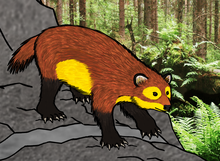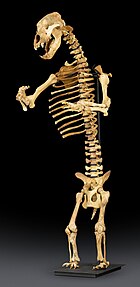安卢熊属
| 安卢熊属 化石时期:
| |
|---|---|

| |
| 复原图 | |
| 科学分类 | |
| 界: | 动物界 Animalia |
| 门: | 脊索动物门 Chordata |
| 纲: | 哺乳纲 Mammalia |
| 目: | 食肉目 Carnivora |
| 科: | 熊科 Ursidae |
| 属: | †安卢熊属 Ballusia Ginsburg & Morales, 1998 |
| 模式种 | |
| †Ballusia elmensis | |
| Species | |
| |
安卢熊属(学名:Ballusia)是一个灭绝的小熊属,生存在早中新世,大约2005万至1800万年前。被归入该属的化石遗骸在欧洲(波兰)和亚洲(俄罗斯、蒙古、中国)都有发现[1][2]。安卢熊属是在1998年建立的,最初是基于被归为祖熊属和半熊属不同物种的化石,其中B. elmensis是模式种[3]。
安卢熊属与“真正”的熊(包括现代的熊亚科)的确切关系尚未完全理解:许多古生物学家将其归类为熊亚科的原始成员,但其已知的骨骼元素与灭绝的半狗亚科有一些共同特征。因此,一些研究者将Ballusia称为Ursidae incertae sedis[3]。Ginsburg和Morales认为B. elmenensis是祖熊属的祖先,Marciszak和Lipecki也是这样认为的,尽管两个属的时间范围似乎有重叠[4] [5]。
描述
安卢熊属比大多数现代熊物种都要小:该属物种B. orientalis[6]的化石遗骸表明这种动物的大小与家猫相似,身体比例类似于狼獾,而B. elmenensis的大小则与欧亚山猫相似[4]。安卢熊属具有纤细的腿部[7],相对于现代熊物种来说,它的尾巴也更长。
参见
参考资料
- ^ Baryshnikov G.F. & Lavrov A.V. (2015). "Early Miocene bear Ballusia (Carnivora, Ursidae) from the locality Khirgis-Nur-I in Mongolia". Proceedings of the Zoological Institute RAS 319(3): p. 341–350
- ^ Sotnikova M, Klementiev A, Sizov A & Tesakov A (2021). "New species of Ballusia Ginsburg and Morales, 1998 (Ursidae, Carnivora) from Miocene of Eastern Siberia, Russia". Historical Biology 33(4): p. 486-497. doi.org/10.1080/08912963.2019.1637864
- ^ 3.0 3.1 Ginsburg L & Morales G (1998). "Hemicyoninae (Ursidae, Carnivora, Mammalia) and the related taxa from Early and Middle Miocene of Western Europe". Annales de Paléontologie 84(1): p. 71-123. doi.org/10.1016/S0753-3969(98)80003-7
- ^ 4.0 4.1 Marciszak A & Lipecki P (2020). "The history of bears (Ursidae, Carnivora, Mammalia) from Silesia (southern Poland) and the neighbouring areas". Geological Quarterly 64(4): p. 876–897 (页面存档备份,存于互联网档案馆)
- ^ Qui Z-X, Deng T & Wang B-Y. (2014). "A Late Miocene Ursavus skull from Guanghe, Gansu, China". Vertebrata PalAsiatica 52(3): p. 265-302 (页面存档备份,存于互联网档案馆)
- ^ Qui >, Yan D, Hang J & Wang B (1985). "Dentition of the Ursavus skeleton from Shanwang, Shandong Province". Vertebrata PalAsiatica 23: p. 264-275
- ^ Jiangzuo Q & Flynn J.H. (2020). "The Earliest Ursine Bear Demonstrates the Origin of Plant-Dominated Omnivory in Carnivora". IScience 23(6): doi.org/10.1016/j.isci.2020.101235 (页面存档备份,存于互联网档案馆)
| ||||||||||||||||||||||||||||||||||||||||||||||||||||||||||||||||||||||||||||||||||||||||||||||||||||
Text is available under the CC BY-SA 4.0 license; additional terms may apply.
Images, videos and audio are available under their respective licenses.

